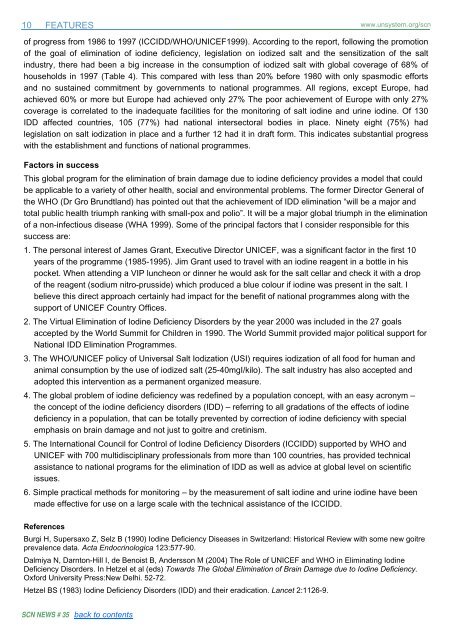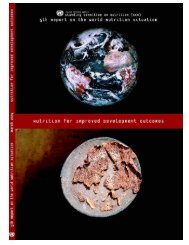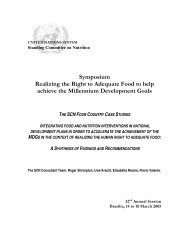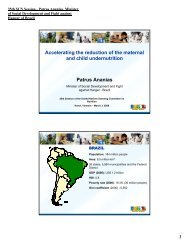Universal Salt Iodization (USI) - FTP Directory Listing
Universal Salt Iodization (USI) - FTP Directory Listing
Universal Salt Iodization (USI) - FTP Directory Listing
- No tags were found...
Create successful ePaper yourself
Turn your PDF publications into a flip-book with our unique Google optimized e-Paper software.
10FEATURESwww.unsystem.org/scnof progress from 1986 to 1997 (ICCIDD/WHO/UNICEF1999). According to the report, following the promotionof the goal of elimination of iodine deficiency, legislation on iodized salt and the sensitization of the saltindustry, there had been a big increase in the consumption of iodized salt with global coverage of 68% ofhouseholds in 1997 (Table 4). This compared with less than 20% before 1980 with only spasmodic effortsand no sustained commitment by governments to national programmes. All regions, except Europe, hadachieved 60% or more but Europe had achieved only 27% The poor achievement of Europe with only 27%coverage is correlated to the inadequate facilities for the monitoring of salt iodine and urine iodine. Of 130IDD affected countries, 105 (77%) had national intersectoral bodies in place. Ninety eight (75%) hadlegislation on salt iodization in place and a further 12 had it in draft form. This indicates substantial progresswith the establishment and functions of national programmes.Factors in successThis global program for the elimination of brain damage due to iodine deficiency provides a model that couldbe applicable to a variety of other health, social and environmental problems. The former Director General ofthe WHO (Dr Gro Brundtland) has pointed out that the achievement of IDD elimination “will be a major andtotal public health triumph ranking with small-pox and polio”. It will be a major global triumph in the eliminationof a non-infectious disease (WHA 1999). Some of the principal factors that I consider responsible for thissuccess are:1. The personal interest of James Grant, Executive Director UNICEF, was a significant factor in the first 10years of the programme (1985-1995). Jim Grant used to travel with an iodine reagent in a bottle in hispocket. When attending a VIP luncheon or dinner he would ask for the salt cellar and check it with a dropof the reagent (sodium nitro-prusside) which produced a blue colour if iodine was present in the salt. Ibelieve this direct approach certainly had impact for the benefit of national programmes along with thesupport of UNICEF Country Offices.2. The Virtual Elimination of Iodine Deficiency Disorders by the year 2000 was included in the 27 goalsaccepted by the World Summit for Children in 1990. The World Summit provided major political support forNational IDD Elimination Programmes.3. The WHO/UNICEF policy of <strong>Universal</strong> <strong>Salt</strong> <strong>Iodization</strong> (<strong>USI</strong>) requires iodization of all food for human andanimal consumption by the use of iodized salt (25-40mgI/kilo). The salt industry has also accepted andadopted this intervention as a permanent organized measure.4. The global problem of iodine deficiency was redefined by a population concept, with an easy acronym –the concept of the iodine deficiency disorders (IDD) – referring to all gradations of the effects of iodinedeficiency in a population, that can be totally prevented by correction of iodine deficiency with specialemphasis on brain damage and not just to goitre and cretinism.5. The International Council for Control of Iodine Deficiency Disorders (ICCIDD) supported by WHO andUNICEF with 700 multidisciplinary professionals from more than 100 countries, has provided technicalassistance to national programs for the elimination of IDD as well as advice at global level on scientificissues.6. Simple practical methods for monitoring – by the measurement of salt iodine and urine iodine have beenmade effective for use on a large scale with the technical assistance of the ICCIDD.ReferencesBurgi H, Supersaxo Z, Selz B (1990) Iodine Deficiency Diseases in Switzerland: Historical Review with some new goitreprevalence data. Acta Endocrinologica 123:577-90.Dalmiya N, Darnton-Hill I, de Benoist B, Andersson M (2004) The Role of UNICEF and WHO in Eliminating IodineDeficiency Disorders. In Hetzel et al (eds) Towards The Global Elimination of Brain Damage due to Iodine Deficiency.Oxford University Press:New Delhi. 52-72.Hetzel BS (1983) Iodine Deficiency Disorders (IDD) and their eradication. Lancet 2:1126-9.SCN NEWS # 35 back to contents







